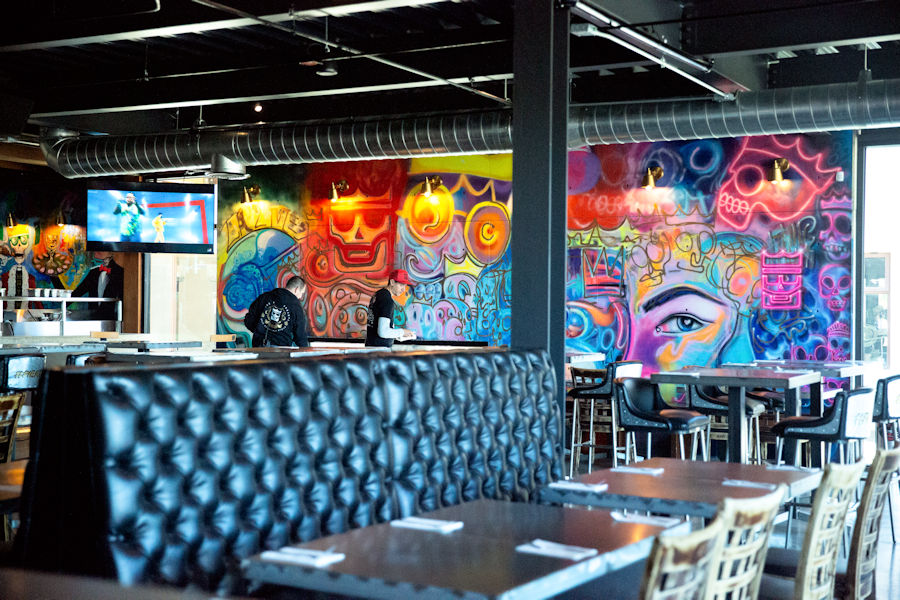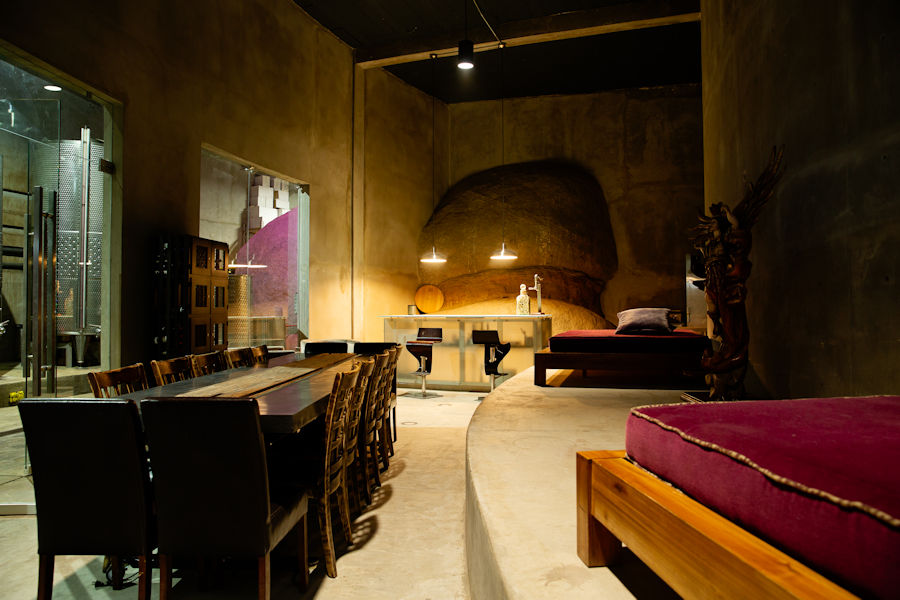 |  |
Midwinter and the rolling hills are covered in clean rows of leafless vines. Recent rains have cleared away the hot dusty days of summer. From the stoplight at San Antonio de las Minas, proceed to the narrowing road into two lanes and make a U turn. Turn right at the sign. From there it is only minutes on a paved road to the entrance to Rondo del Valle. This is a fairly new project for Albert Cruz, but the history of his father’s land goes back to 1977. The architecture is contemporary with clean lines in all glass, steel and stone.
Entering through the massive wooden door, sunlight fills the space and the room captures the view. To the left is a wide open room where, during harvest, the grapes come in through one end of the building, placed on a conveyor belt to be sorted and de-stemmed. The juice will flow by gravity feed into the stainless fermentation tanks below. If you visit during the months of August and September, you might find that the tasting bar has been pushed to the far wall and you can enjoy tasting while watching one of the important steps in winemaking.

To enjoy yourself you can choose from several seating options which can include a cellar tasting made by reservation. Today Albert Cruz greets me and suggests we do just that. Tasting wine in the cellar, where the barrel room is a special experience and lends itself to further enjoying the afternoon. As we make the two flights of stairs to the cellar we pass a waterfall sliding down the face of the rock wall. This is quite unique, but also has the benefit of adding necessary humidity to the cava. Rows of stainless steel tanks stand like silent sentinels at the foot of the stairs. A separate room holds the slumbering barrels in different stages of aging. Albert is a lively conversationalist and a great storyteller as we head deep into the cava. He tells the story about why the huge boulder in the middle of the room was left in place. He pats the side of the towering rock and spins the tale of how he thought first to remove this megaton rock. But realized the time/money factor involved and wanted to move ahead with the project. As it turns out, this massive boulder is an added attraction, revealing what the whole Guadalupe valley looks like just under the surface.
Albert talks about each wine that will be served today and how the label tells a story. He introduces the first wine, a young 2019 Grenache and Malbec blend. I was quite surprised by its presence in the glass for a young wine. It was expressive and full bodied, coming from the Malbec varietal and was classy for its age. It opened out with a touch of herb and fresh fruit, calling for a sharp cheese or caramel covered walnuts.
As Albert poured the 2018 Travesí he shared several stories of how it all began. His father worked for Hewlett Packard in the states for many years. But he had a desire to return to his homeland. He bought the land in 1977 that had once been a vineyard growing the Chenin Blanc grape. One of the rather sad historic events in the Guadalupe Valley is a period of time when many farmers were growing grapes for only a few wineries existing at that time. A downturn in the wineries’ needs for the grapes, forced the farmers to tear out the vines and plant crops in order to survive. This happened to many grape growers who regret this today as those grapes would be the highly sought after “old growth vines”. No one back then could have imagined the explosion of wineries that has happened in the last 10 years. Albert shifts to an outrageous story describing the first time he ordered a shipment of grapes. He thought he had ordered just enough to make his first garage wine for the family. But when the tons of grapes showed up he was overwhelmed. A wild and passionate winemaker came to his rescue, Reynaldo Rodriguez. Reynaldo exclaimed that the grapes were warming, left in the sun, and this is a real no no! For the freshly harvested grapes must be chilled before fermentation. Reynaldo told Albert he would meet him at 1:00 in the morning! They would work until the sun came up. Reynaldo believed in immersing oneself in the passionate affair of making wine. Often, Reynaldo would playfully throw grapes at Alberto, splashing him with juicy skins and stems during the processing. Today, Sergio Heras is Rondo del Valle’s oenologist. As we finish the wonderful Travesí, a Merlot, Cabernet and Malbec blend of the Travesí label, Alberto quotes from his father, “Life is a cycle, a journey where your passion and hard work will bring you back to the origins” as his father did for Albert.

Wine tasting can be one of the best ways to learn what it takes to make good wine. Passion and patience of course, but good grapes have to have good soil and weather. The label for the 2017 Cab and Merlot, Cautivo, “captive,” pictures two strong hands filled with soil. Alberto shares how loving something can also imprison you. He tells how the gift of the land from his Dad brought him to the valley, “I don’t know how, but the Guadalupe Valley made me a captive.” The Cautivo blend, also captivated me with its ripe fruit and deep dark elegant plum. “Could there be a note of cactus?” I asked. We stopped to taste again. It was so subtle; a cactus fruit called, tunas. We thought this might be a new taste discovery in Baja California wines.
Saving the best for last Albert graciously suggested a unique experience in tasting. We would taste two bottles of the Morador label. He would first pour a 2013 blend of Merlot, Cabernet, Sauvignon, and Syrah with 14 months in French oak; now with 6 years in the bottle made by Reynaldo Rodriguez. We would follow this with the same blend, but a 2015 made by Sergio Heras. This was truly an amazing experience and how different the two blends were. As was Reynaldo’s passionate nature the fruit nearly leapt from the glass. Red brick in color. This wine demanded full attention to its complexity. It took the fruit to its limit. You could almost call it lusty elegance. The Sergio Morador’s representation of this blend was wonderful and easier for the palate to understand. Alberto stressed, “With Reynaldo’s BIG wine you either love it or hate it.” I loved it, but there was a problem, reported Albert, “There are only two cases left and so we would share this by reservation only.” This tasting was a very enlightening experience and served in the appreciation of the artistry of each winemaker. Baja California wines are known for breaking old world traditions. New winemakers in the Guadalupe Valley continue to bring in innovation and take the risks to do that, with passion and patience.
Article by Martina
Photography by Cintia Soto

Great price and really easy to buy coverage online. However, you never really know how good the...

It was so easy to get peace of mind for our trip! The rate was very reasonable. The girl I spoke...

2nd time purchasing Bajabound MX insurance while on the road. Super Easy, excellent interactive...